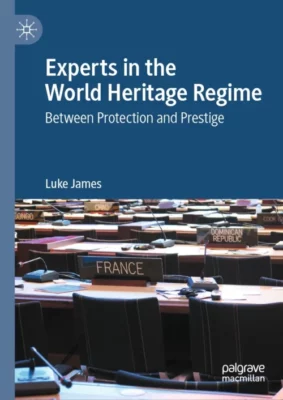- Max Bourke, AM reviews Experts in the World Heritage Regime – Between Protection and Prestige by Luke James, Palgrave Macmillan, 2024.
With conservation at the heart of the Australian Garden History Society philosophy, World Heritage places (including 20 in Australia that occasionally make headlines, usually for unhappy domestic political events) are often on the bucket list of AGHS members. But the institution that gives this list its life is little known.
This book sets out to open the World Heritage listing process up to daylight and its author has done that very, very thoroughly! I assume it started out as a PhD thesis or is certainly derived from one. Nothing wrong with that of course but the narrative chases ideas exhaustingly down rabbit burrows that might well have been left as rabbit scratchings (see for instance the diversion into the origins of the Linnean binomial system!).
The frame of the book is the 50th anniversary of the World Heritage Convention:
In 2022 commemorations took place to mark the 50th anniversary of one of the most—if not the most—consequential international treaties for global conservation. As has been noted by at least one commentator, the United Nations Educational, Scientific and Cultural Organization (UNESCO) Convention Concerning the Protection of the World Cultural and Natural Heritage (hereafter the ‘Convention’) has, in human terms, well and truly reached middle-age. Yet while this milestone was the source of celebration, it fell during a lengthy period of reflection. The undoubted success of the Convention at infiltrating the global imagination had for some time been joined by ambivalence from those who observed its governance up close.
I would add to those concerns that many of us were seeing how so many sites were being trashed by poor management and heavy tourism.
Currently the World Heritage List (WHL) covers 1200 sites with 196 State Party members, perhaps one of the most ‘successful’ conventions ever introduced by the UN system…perhaps not? James sets out to explore this in detail. He writes well and, especially for the small pool of us who have had more than 50 years of connection to the World Heritage Convention, the book is fascinating. I commend him for his work.
Australia has been closely involved since the beginning. Well known founder of Australian archaeology, the late Professor John Mulvaney, attended the first meeting of the Committee in 1978. At the time, he was my colleague on the Australian Heritage Commission and, because we were not allowed to send anyone overseas, John ‘volunteered’ as he was on sabbatical in Cambridge! Since then a number of Australians, including myself, have worked in various roles associated with running the Convention.
James works closely through what he sees as the ‘gradual’ politicisation of the WHL. But it has long been so. In the early ‘80s ICOMOS came under intense pressure – I was then Deputy Chair − over Indian nominations. The Indian Government had nominated Mahabalipuram in Tamil Nadu but experts with knowledge of the site thought it was poorly documented and even more poorly managed so it was knocked back initially. Indian officials as well as experts lobbied furiously to persuade ICOMOS to change its views. Eventually it was listed and now is a site being overwhelmed by visitors.
In an astute observation, James says:
As a [World Heritage] Committee member, the chance that your views are…accepted increases tremendously with your knowledge of the procedures’ observed an expert from a former Committee member delegation and Advisory Body World Heritage Advisor. This may mean knowledge of the appropriate paper forms, but also of forms of appropriate speech; a sense of what has come before that will largely—but not entirely—prefigure what is possible in the present. Adopting a habitus particular to the World Heritage regime with its frequent transgressions of its own rules, these are the participants who have developed that ‘feel for the game’.
This is quite true in my view. Having once attended, as expert ‘counsel’ to Gough Whitlam when he was Ambassador to UNESCO and delegate to WHC, I have never forgotten Whitlam’s wonderful ‘feel for the game’. After an abnormally long intervention by a delegate, Gough leaned over to me, across his live microphone and observed in that wonderful husky voice and his limited French, ‘Comrade he is talking merde de rat isn’t he?’. This was broadcast to the entire auditorium.
James tells a terrific story about the way in which Singapore as a newish World Heritage Convention member curried favour, by donating an orchid named after UNESCO, in order to get its superb Botanic Gardens listed. However as a friend, later, of the Director, Dr Nigel Taylor, and (voluntary) reviewer of the nomination for ICOMOS, I assure you it should be listed!

I have visited, by my reckoning, more than 100 of the 500 current World Heritage sites. A few are well managed. All, more or less, are at risk from climate change at the least and over-exploitation at the most. Listing has been an awful ’Faustian’ bargain (to quote James), more like a footnote to the great salutary poem ‘Ozymandias’ by Percy Bysshe Shelley:
My name is Ozymandias, King of Kings;
Look on my Works, ye Mighty, and despair!
Nothing beside remains. Round the decay
Of that colossal Wreck, boundless and bare
The lone and level sands stretch far away.
I would give as an example France and its terrible management of the Corsican site, the Gulf of Porto, which I have walked over. Overgrazing, neglect and bad land management abound in an area of great intrinsic beauty. But equally some of our own sites like the Great Barrier Reef are in dire straits (bad pun).
James does come to a positive conclusion, with which I agree:
While we may not be able to reliably locate a time before politicisation, neither should we downplay the achievements of the first two dozen years of the World Heritage regime. By 1996, three-quarters of states recognised by the United Nations, including nearly all of today’s OECD members, were States Parties to the Convention, and the World Heritage List contained over 500 sites in 110 states. The Convention had played a determinative part in the protection of sites of such global cultural and natural significance as Delphi, the classical Greek site, the inscription of which in 1987 was made conditional on relocating a proposed aluminium plant, and the 1982 listing of the Tasmanian Wilderness, which enabled the Australian Government to thwart the state of Tasmania’s proposed damming of the Franklin River and the immense destruction of culture and nature that would have entailed.
I would add that the regime has often been used to try, perhaps without success, to preserve/mitigate awful things happening to the Great Barrier Reef.
Writing of the ‘politicisation’ of an organ of UNESCO is a fraught business when one remembers that even the founding Director of that body, the famous scientist Dr Julian Huxley, was virtually sacked (his term having been ’shortened’ was the expression) for what were obvious political reasons. Furthermore, as James shows, this is also a place where people’s efforts to protect of the world’s heritage are also a pursuit for prestige.
Experts in the World Heritage Regime is available as an epub and hardcover.


